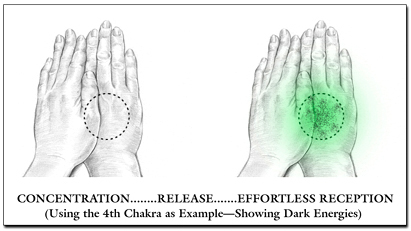Healing Level II
LEARNING TO VIEW THE CHAKRA COLORS
As an advanced exercise, you may, if you wish, begin to attempt to view the colors of the chakras as an aid to further informing yourself of the condition of your patient. This is an optional step. It is not necessary to attempt to view the chakra colors to give an effective treatment at this level, yet you may find this an interesting technique to try.
As you know, each of the seven major chakras has an associated true color, from red for the 1st chakra, up to violet for the 7th. Chakras, when healthy, show a strong, healthy glow of their corresponding true color. Diseased chakras, however, display a discolored, faded, watery or streaked appearance. A chakra appearing this way is defective in its energetic functioning and in need of extra treatment. In diseased chakras, it is common for darkened areas to be visible, or colors or hues that are not appealing to the healer. As with the aura, healthy and appealing-looking colors indicate healthy conditions, and unappealing and unhealthy-looking colors indicate impurities and undesirable conditions. Begin to learn to see the chakra colors with the following technique:

Learning to View The Chakra Colors
While performing the usual hand positions on the front of the body, check the color of the chakras by observing, in your mind's eye at first, the subtle color hue on the skin of the back of your own hand as you treat each chakra. The color, apparently reflected in your skin, will be from the patient's own chakra field, and illuminates your skin to your subtle sight. This may be "seen," while learning, by performing an intuitive reading: concentrate briefly on the skin on the back of your right hand (which is centered over the chakra) during the active phase, and then glance away (as when using the glancing technique to learn to view the aura) while releasing into the receptive phase. You may still "see" the skin on the back of your right hand, in your mind's eye, yet may also receive an impression of color, either strong and fairly pure or weakened, darkened or discolored with impurities, on the surface of the skin on the back of your hand.
Look back then, at the top surface of your right hand, to attempt to confirm the color hue you saw in your mind's eye, just as you do while practicing viewing the aura. The general tone of the chakra color, with any impurities or discolorations, will appear as a subtle yet discernible hue, to your mind's eye at first, and eventually to your physical eyes also. You may not see the chakra color at first—it may require substantial practice. After practice, however, you may be able to view the chakra color directly, without looking away, as the chakra color effortlessly appears to your psychic sight. Colors other than the native color of the chakra may also appear—you will learn much more about colors in the chakras, and their meaning, in Chios Level III.
This is a good technique to incorporate into your treatments, if you wish. Briefly assess the color of each chakra as you treat it in the usual order. You will have impressions of chakra colors, perhaps including indications of impurity, as you move your hands to the different chakra positions. Those chakras that show a poor color hue should be treated with extra energy during hand placement to help restore their hue. You may be able to view changes in the hue, and work to restore it.
As you become more aware of chakra colors, you may also get information of this sort during your initial assessment of your patient during your reception of psychic information and guidance, or as impressions as you view the field. Be open to the chakra colors, and you will find that this information will come to you at various points during treatment. Combine all your assessments into a complete sense of chakra condition, and treat accordingly.
©1994 - 2011 Stephen H. Barrett